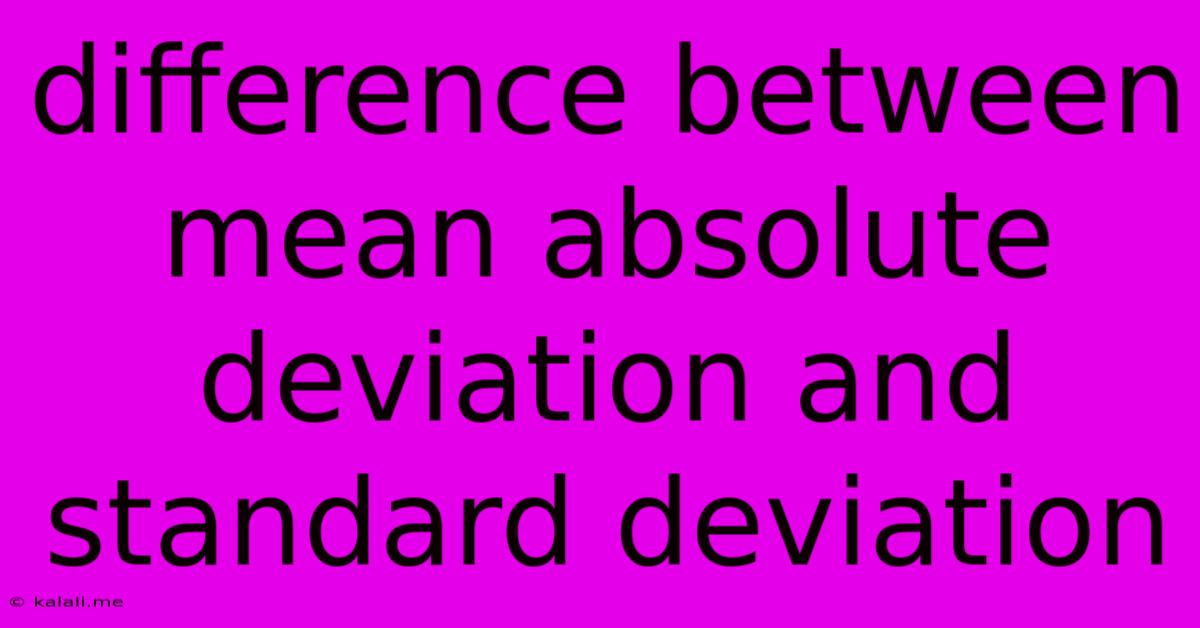Difference Between Mean Absolute Deviation And Standard Deviation
Kalali
Jun 09, 2025 · 3 min read

Table of Contents
Mean Absolute Deviation vs. Standard Deviation: Understanding the Key Differences
Understanding how data is spread out is crucial in statistics. Two common measures for this are the mean absolute deviation (MAD) and the standard deviation (SD). While both quantify dispersion, they differ significantly in their calculation and interpretation. This article delves into these differences, helping you choose the appropriate measure for your data analysis needs. This guide will clarify the distinctions, enabling you to confidently select the most suitable method for your statistical analysis.
What is Mean Absolute Deviation (MAD)?
The Mean Absolute Deviation represents the average distance between each data point and the mean of the dataset. It's a simple measure of variability that focuses on the absolute differences, ignoring the direction (positive or negative) of the deviations. This makes it relatively easy to understand and calculate. A lower MAD indicates less variability, while a higher MAD suggests more spread in the data.
Calculating MAD:
- Calculate the mean: Sum all the data points and divide by the number of data points.
- Find the absolute deviations: For each data point, subtract the mean and take the absolute value (remove any negative signs).
- Calculate the average absolute deviation: Sum all the absolute deviations and divide by the number of data points.
Example: For the dataset {2, 4, 6, 8}, the mean is 5. The absolute deviations are |2-5|=3, |4-5|=1, |6-5|=1, |8-5|=3. The MAD is (3+1+1+3)/4 = 2.
What is Standard Deviation (SD)?
Standard deviation, unlike MAD, considers the squared differences between each data point and the mean. This squaring emphasizes larger deviations, giving them more weight in the calculation. The final step involves taking the square root to return the deviation to the original units of measurement. A lower standard deviation indicates data points are clustered closely around the mean, while a higher standard deviation shows greater dispersion. It's a more commonly used measure of variability because of its properties in statistical inference and its compatibility with other statistical techniques.
Calculating SD:
- Calculate the mean: As with MAD.
- Find the squared deviations: For each data point, subtract the mean, square the result.
- Calculate the variance: Sum all the squared deviations and divide by the number of data points (for a population standard deviation; divide by n-1 for a sample standard deviation).
- Calculate the standard deviation: Take the square root of the variance.
Example: Using the same dataset {2, 4, 6, 8}, the squared deviations are (2-5)²=9, (4-5)²=1, (6-5)²=1, (8-5)²=9. The variance is (9+1+1+9)/4 = 5. The standard deviation is √5 ≈ 2.24.
Key Differences Summarized:
| Feature | Mean Absolute Deviation (MAD) | Standard Deviation (SD) |
|---|---|---|
| Calculation | Uses absolute deviations | Uses squared deviations |
| Weighting | Treats all deviations equally | Weights larger deviations more heavily |
| Sensitivity | Less sensitive to outliers | More sensitive to outliers |
| Interpretation | Average distance from the mean | Spread around the mean |
| Use Cases | Simpler calculations, easier to understand | More robust statistical analysis, better for inferential statistics |
Which Measure to Choose?
The choice between MAD and SD depends on the specific context and the goals of the analysis.
-
MAD: Suitable when simplicity and ease of understanding are prioritized, or when outliers are a major concern. It's less sensitive to extreme values.
-
SD: Preferred for most statistical analyses, particularly those involving inferential statistics (hypothesis testing, confidence intervals). It's more mathematically tractable and has desirable properties for statistical modeling. However, its sensitivity to outliers should be considered.
In conclusion, both MAD and SD are valuable tools for measuring data dispersion. Understanding their differences allows you to select the most appropriate measure to effectively communicate the spread of your data and draw meaningful conclusions from your analysis. Choosing the right measure is critical for accurate data interpretation and effective communication of results.
Latest Posts
Latest Posts
-
Set Audit Fields Upon Record Creation
Jun 09, 2025
-
Size Of The Moon Compared To The Sun
Jun 09, 2025
-
String Or Binary Data Would Be Truncated Sql
Jun 09, 2025
-
Questions To Ask A Potential Phd Advisor
Jun 09, 2025
-
Do You Use Cite Text When Summarizing A Story
Jun 09, 2025
Related Post
Thank you for visiting our website which covers about Difference Between Mean Absolute Deviation And Standard Deviation . We hope the information provided has been useful to you. Feel free to contact us if you have any questions or need further assistance. See you next time and don't miss to bookmark.